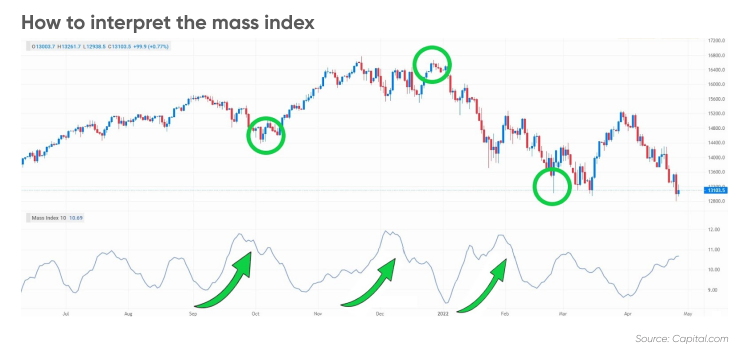The first step is to set the time period for the indicator. The above example shows 25-periods but this can be sped up to 10-periods too.
The second step is to calculate the range between the high and low prices over each bar or candle within the set period. For example, if 25 days is set, then first the difference between the highest price and lowest price on day one would be calculated, then the difference between the high and the low on each next day, all the way to the 25th day.
The third step is to calculate the nine-day exponential moving average (EMA) of the range between the high and low prices over the set period.
The fourth step is to divide this figure by the nine-day exponential moving average of the moving average in the numerator.
Who invented the mass index?
The mass index was created by Donald Dorsey. He published an article about the mass index in the Technical Analysis of Stocks & Commodities magazine in June 1992. He used the mass index as his own variation on ‘range oscillation analysis’, which indicates how much the price range oscillates over time.
Dorsey claimed his mass index and range oscillation analysis “allows the technician to forecast market reversals that other indicators may miss”.
Why is the mass Index useful for traders?
What is mass index doing to help with day trading? Traders use the indicator as a visual representation of what often happens to the range of price bars before a price reversal occurs.
The mass index indicator uses a mathematical formula to interpret how the range between the high and low of a market price changes over a given time period.
The range of a price bar is one of the simplest calculations of volatility. If the range is low, the price has not moved very much and the volatility is low.
Markets tend to repeat a pattern where the average daily range (ADR) moves from low to high and back to low again. This same concept can be seen in Bollinger bands, which oscillate from times when the bands are very close together and very far apart.
This pattern of when the daily range changes can be a useful indication that a market reversal is taking place. This is what is mass index
How to interpret the mass index
Donald Dorsey said that the most important signal in range oscillation analysis is the ‘reversal bulge’. This he defines as “a gradual but definite increase of the average daily range that indicates the market is near a turning point”.
It is hard to look at how the daily (or intraday) range is changing with the naked eye, which offers some justification for the use of a technical indicator like the mass index.
What is the mass index showing? As seen in the chart below, surges in the mass index can correlate with turning points in the price trend. When the indicator makes a big upward move and then turns lower again from the extreme reached, the indicator is modelling what is happening to the range of the price bars.
The price range is increasing quickly as a trend accelerates, but then decreases from an extreme level, signalling that volatility is slowing during the turning. The idea would be to enter a trade before the momentum increases in the new direction.









